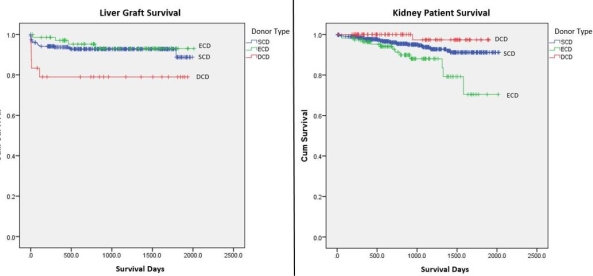Kidney and Liver DCD Outcomes – A Five Year Review
1Transplant Surgery, Tampa General Medical Group, Tampa General Hospital, Tampa, FL
2Pre-Med Undergraduate, University of South Florida, Tampa, FL
3Transplant Research, Tampa General Hospital, Tampa, FL
4Internal Medicine, Morsani College of Medicine, University of South Florida, Tampa, FL.
Meeting: 2018 American Transplant Congress
Abstract number: D128
Keywords: Donors, Kidney transplantation, Liver transplantation, non-heart-beating, Outcome
Session Information
Session Name: Poster Session D: Kidney Donor Selection / Management Issues
Session Type: Poster Session
Date: Tuesday, June 5, 2018
Session Time: 6:00pm-7:00pm
 Presentation Time: 6:00pm-7:00pm
Presentation Time: 6:00pm-7:00pm
Location: Hall 4EF
Background: The demand for organ transplantation exceeds the supply and has led to an increase in use of donation after cardiac death (DCD) solid organs for transplantation. Hypothesis: We hypothesized no difference in outcomes of DCD kidney and liver transplants compared to extended criteria donors (ECD) and standard criteria donors (SCD). Methods: We conducted a retrospective cohort study of all consecutive deceased donor liver and kidney transplants from January 2012 – December 2016. The analysis was performed using ANOVA (continuous variables) and chi-square test (binary variables). Time to event data were analyzed using cox-regression and summarized as hazard ratio (HR) with 95% confidence intervals (CI). Statistical significance was set at 5% for all comparisons. Results: At our center, we performed 1,271 deceased kidney transplants (KT) and orthotopic liver transplants (OLT). Bilateral, en-bloc and combined organs were excluded from our analysis (N=1,117). There were 748 single KTs (86 DCD, 111 ECD, and 551 SCD) and 369 OLT (24 DCD, 70 ECD, and 275 SCD). Mean KT donor age was 38 (DCD), 59 (ECD) and 36 (SCD); P<.0001; whereas, OLT donor age was 35 (DCD), 60 (ECD) and 35 (SCD); P<.0001. There was no significant difference in cold ischemic time, KT (P=.197) and OLT (P=646.). Graft survival was statistically significant for OLT favoring SCD vs. DCD (HR=.33; 95% CI .12 to .89; P=0.028) and ECD vs. DCD (HR=.25; 95% CI .07 to .94; P=0.039). Graft survival was not significant for KT (P=.777). Overall patient survival was statistically significant for KT favoring DCD vs. ECD (HR=10.8; 95% CI 1.4 to 83.0; P=0.022. However, overall patient was not significant for OLT (P=.313). Conclusion: Our results indicate better patient survival with DCD kidneys and poorer graft survival with DCD livers. These finding should help guide recipient selection when utilizing DCD donors. 
CITATION INFORMATION: Buggs J., Boone J., Adesunkanmi M., Mehta R., Rogers E., Kumar A., Alsina A., Bowers V. Kidney and Liver DCD Outcomes – A Five Year Review Am J Transplant. 2017;17 (suppl 3).
To cite this abstract in AMA style:
Buggs J, Boone J, Adesunkanmi M, Mehta R, Rogers E, Kumar A, Alsina A, Bowers V. Kidney and Liver DCD Outcomes – A Five Year Review [abstract]. https://atcmeetingabstracts.com/abstract/kidney-and-liver-dcd-outcomes-a-five-year-review/. Accessed December 14, 2025.« Back to 2018 American Transplant Congress
